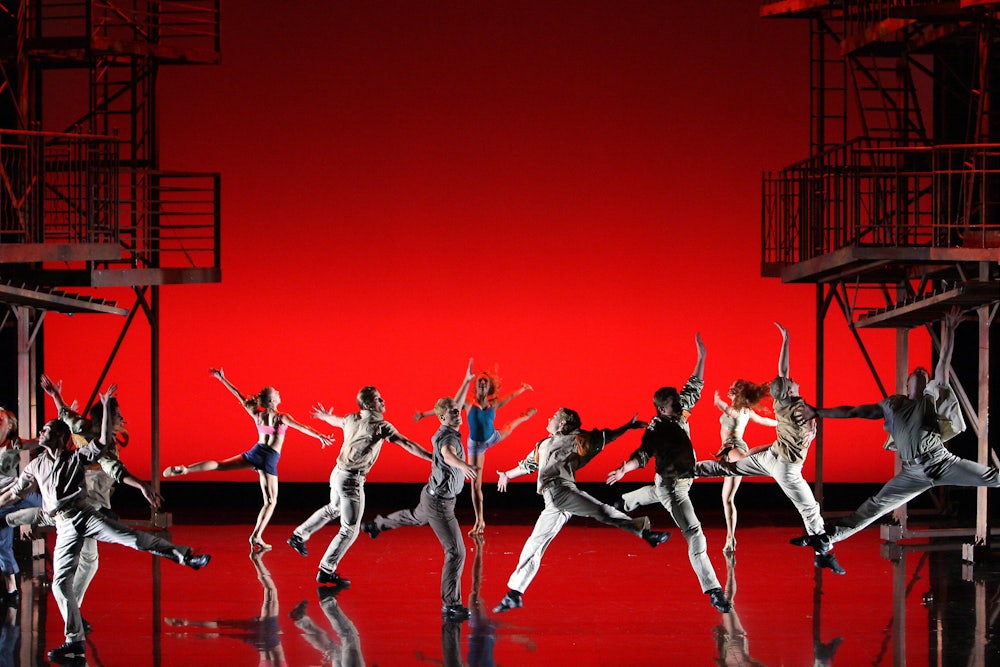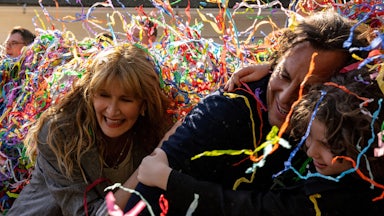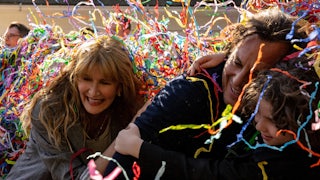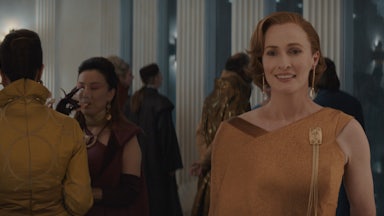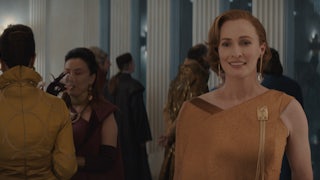It’s been a pastime of mine for many years to wonder where it is that West Side Story takes place. You might say that’s like asking the color of George Washington’s white horse. The West Side of Manhattan, dummy! Yes, but where on the West Side?
The answer turns out to be: west. Way west. Like, Los Angeles. Which explains why both the original West Side Story and its recent remake commit the disconcerting sociological error of airbrushing African Americans out of the setting.
We’ve seen a lot of essays in the last week faulting West Side Story, even in its newest version, for its treatment of Puerto Ricans, who migrated in record numbers to New York City after World War II. But the larger ethnic insult, it seems to me, is that West Side Story pretends that an even bigger postwar migration never took place. That’s the Black migration into New York City from the segregated South, which began decades earlier and prompted at least as much ethnic prejudice. (The deficit is addressed very indirectly by casting the Afro-Latina actress Ariana DeBose as Anita.)
The new film sets the action in San Juan Hill, the slum in the West 60s cleared by Robert Moses to build Lincoln Center, and it portrays the neighborhood as a battleground between whites and Puerto Ricans. But in fact, San Juan Hill was a Black neighborhood of long standing, into which Puerto Ricans migrated during the postwar years. There was never much gang activity there during the 1950s. These jarring story elements make sense only when you learn that West Side Story’s creators drew inspiration not from gang wars in New York City but rather from gang wars in Los Angeles.
It was in L.A. that teenage gangs first burst onto the national consciousness with the 1943 Zoot Suit riots. The riots were provoked by Anglo GIs stationed in L.A., en route to the Pacific. The GIs harassed Mexican-American pachucos for flouting wartime regulations that outlawed the pachucos’ baggy zoot suits (because they used too much fabric). An argument ensued, and a uniformed Navy sailor was beaten up. In retaliation, 50 U.S. sailers marched through downtown Los Angeles and beat with clubs anyone in a zoot suit they could find. The result was six days of violence between servicemen and pachucos. These riots were, First Lady Eleanor Roosevelt said, a “racial protest.” L.A. Mayor Fletcher Bowron replied that the Chicano rioters were gang members. Both were right.
In 1949, the choreographer and stage director Jerome Robbins, the composer Leonard Bernstein, and the librettist Arthur Laurents started working on a project titled East Side Story, updating Romeo and Juliet with the Montagues and Capulets recast as warring Jewish and Catholic families (not gang members) on the Lower East Side of Manhattan. The action was set during Passover and Easter. There really were East European Jews and Italian Catholics living in adjacent neighborhoods in the Lower East Side, but Laurents couldn’t make the story work, and they dropped the whole thing after someone pointed out that a love story about a Jew and a Catholic would make East Side Story sound an awful lot like the hackneyed 1922 Broadway comedy Abie’s Irish Rose.
Six years later, in the summer of 1955, Robbins revived the Romeo and Juliet idea, and Bernstein and Laurents talked about building a story around juvenile gang wars, which by then had become big news. (An FBI report would later assert that juvenile court cases increased 220 percent between 1941 and 1957, the year West Side Story premiered on Broadway.) But where to set it? “The locale came into focus,” according to Julia L. Foulkes’s 2016 book, A Place for Us: West Side Story and New York, a few weeks later. The locale wasn’t New York. It was Los Angeles.
Bernstein and Laurents were both visiting L.A., Bernstein to conduct five concerts at the Hollywood Bowl and Laurents to do film work. They were both fascinated by news stories about gang violence there. Why not make their Romeo and Juliet about gang violence between Chicanos and Anglos? That really seemed to work. The only problem was that Laurents, though he spent a lot of time in Los Angeles (he had a thriving career writing screenplays), didn’t feel he knew enough about the place to set a script there. So they grafted the Los Angeles narrative onto a place they were more familiar with, Manhattan.
The enduring trouble with this plan was that Manhattan didn’t much resemble L.A.
Portraying gang warfare as a fight between white ethnics and Latinos made sense in Los Angeles, because African Americans were never a big factor in L.A. during the 1950s. In the 1950 census, they represented only 5 percent of the population of Los Angeles County. The great Black migration north that had started during World War I bypassed Los Angeles initially because there weren’t many jobs there; only during World War II, with the advent of L.A.’s booming aerospace industry, did Blacks migrate to L.A. in large numbers.
It was a very different story in New York City. New York was from the very beginning a principal destination for the Great Migration, and by 1950 Blacks represented about 10 percent of New York City’s population. By comparison, Puerto Ricans represented only about 4 percent, though during the following decade massive displacement in Puerto Rico’s agricultural sector would send 470,000 migrants north, the great majority of them to New York City. By 1970, Puerto Ricans represented 10 percent of New York City’s population.
In his 1999 book, Vampires, Dragons, and Egyptian Kings: Youth Gangs in Postwar New York, Eric C. Schneider provides a pretty thorough survey of gang conflict among predominantly white, Black, and Puerto Rican gangs in Manhattan on the Lower East Side, Harlem, East Harlem, Washington Heights, and Hell’s Kitchen. To the extent that Robbins, Bernstein, and Laurents did any field work at all, these were the Manhattan neighborhoods they looked at. Schneider cites San Juan Hill only to mention that it was one of many lower-income neighborhoods bulldozed to make way for luxury housing, public housing, office buildings, and of course Lincoln Center, creating an urgent housing shortage, especially for Blacks and Puerto Ricans, that increased tensions.
White prejudice against Blacks and Puerto Ricans was much more naked and raw in the 1950s than it is today, and it was hardly confined to the group that Lieutenant Schrank, in the West Side Story remake, derides as “the last of the can’t-make-it Caucasians.” Consider Saturday Review theater critic Henry Hewes, who faulted the Broadway musical in October 1957 because it “does not emphasize the utter squalor in which many Puerto Rican immigrants live.” Gang identities were defined by ethnicity, and the gangs weren’t subtle about it. In Hell’s Kitchen there was an Irish-Italian gang called the Nordics.
But the mechanisms of conflict were complicated. Ethnic battlegrounds didn’t exist within neighborhoods, as depicted in all versions of West Side Story, with Jets and Sharks crowded into the same shrinking territory and sharing Doc’s candy store. Rather, the battlegrounds lay between neighborhoods in what Schneider calls the “borderlands.” Whites defended their territory, African Americans defended theirs, and Puerto Ricans theirs. Candy stores, according Schneider, were actually quite important to gangs as meeting places and refuges from the cops. But they were held by one gang or another, never by two, because neutral territory didn’t exist. If your territory expanded, the inhabitants were absorbed into your gang. The result was white gangs with Black or Puerto Rican members, or vice versa. Ethnic identity mattered, but turf mattered more, and turf was considered the common property of all who lived on it.
The notion that West Side Story is set on San Juan Hill conveys the irresistible irony that Leonard Bernstein evoked this neighborhood sympathetically only to move a few years later with his New York Philharmonic into the concrete cultural behemoth that displaced it. But this conceit is false. The play’s setting was never spelled out and was deliberately no less stylized than the singing and balletic dancing in it. Robbins staged the dance numbers in the 1961 movie and was co-director (with Robert Wise) until the producers fired him for spending too much money. According to Foulkes’s book, Robbins fretted a lot that the film’s setting would be too literal and specific. In the end, the 1961 filmmakers made extensive use of the San Juan Hill neighborhood not because the story was supposed to be set there, but because there were a lot of tenements there that were emptied out and awaiting Moses’s demolition, making it a perfect movie set. But the fact that scenes for the 1961 film were shot there doesn’t mean it is set there, or set in Spanish Harlem, where other scenes were shot, any more than the 2021 film is set in Washington Heights, where much of it was filmed (though there is one scene that’s both filmed and set at the Cloisters).
San Juan Hill was a Black neighborhood for a very long time. African Americans moved up there from Greenwich Village after the Civil War, and the name is believed to refer not to the capital of Puerto Rico but to the Battle of San Juan Hill in Cuba, in which the African American Buffalo soldiers played a largely uncelebrated role that was probably more important than that of Teddy Roosevelt (but that’s a whole other story). James P. Johnson, the Black pianist who invented the Charleston, moved to New York’s San Juan Hill in 1908. The great jazz pianist Thelonious Monk was born there in 1917. The 2021 West Side Story would have you believe there were white ethnic teenagers living there in the 1950s who thought San Juan Hill was their home turf, but the great wave of Italian and East European immigration to the United States occurred long after San Juan Hill became a Black neighborhood. A slide show from the Museum of the City of New York surveying the West Side’s history observes that while Puerto Ricans did migrate there in the 1950s, a person walking through the neighborhood then “was more likely to hear the rhythms of jazz than the music of Puerto Rico bomba and plena.”
Maybe half a century from now somebody will film yet another remake of West Side Story. If they do, and if they want to set it in New York, they should consider putting Black youth gangs into the story. Alternatively, they can leave the story mostly intact, rename it West Story, and shift the setting to Los Angeles. I hear there are movie studios there.
